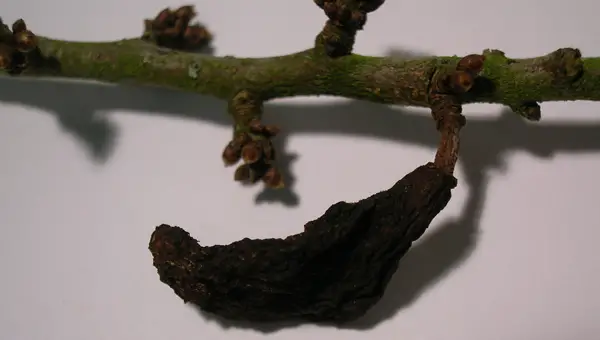A fungal infection causing fruit to grow without their stones, plum pocket affects the young fruit on trees and bushes. The fungus’ scientific name is Taphrina pruni, and it hinders the healthy growth of the fruit, ultimately making it inedible.

This disease affects plums, as the name suggests, but also damsons, and other ornamental relatives. Affected fruits will be misshapen, longer than normal in length, and will be hollow in the middle, without the stone. You may see signs of the fungus on diseased branches which might become deformed. The occurrence of “witches’ broom” is often a symptom of infection too.
Jump To...
Plum Pocket Symptoms
There are some obvious and tell-tale signs that plum pocket exists so it can be fairly easy to diagnose. Below are the most common signs of plum pocket infection on your plum tree:-
Fruit Symptoms
- Fruit will grow in a long and narrow manner, and this will be obvious usually by June time.
- The skin of the fruits may have white marks on it – this is the fungus growth.
- Fruits will not contain their stones and will instead be hollow inside.
- Fruit will not ripen and will instead wither, drop from the tree, and die.
- These fruits that have been affected by plum pocket will not be fit for consumption.
Foliage Symptoms
- If you have plum pocket then the twigs of the affected fruits may be thicker than normal and also deformed.
- You may also see the occurrence of witches’ broom – this is where you find piles of twigs in a cluster, not dissimilar to a broom.
Plum Pocket Treatment & Control
When the fruit has become affected by this fungal problem, any treatment won’t be effective that year. Treatment is about minimising the risk for the following year by taking all the precautionary measures possible.
There are a few things you can do to control the plum pocket for its following life cycle. The one you choose will depend on the severity of the problem.
Organic Control
Here are the most effective organic control methods:
- Removal of diseased branches.
- Remove any visible witches’ brooms.
- Any long and narrow fruit should be removed.
- Regular pruning helps keep fruit trees healthy.
- There have been suggestions that milk and aspirin solutions will help with plum pocket but these haven’t been scientifically proven.
Pesticide Control
Here are the most effective pesticide control methods:
- Fungicides can be used to treat infection.
- Sprays with the active ingredient Difenoconazole can be used.
- These should be used at certain times in the year so read the instructions on the bottle carefully.
Plum Pocket Biology / Lifecycle
Plum pocket is caused by a fungus called Taphrina pruni and is spread through air and water from infected trees. Although you can get this infection in gardens, it’s much more common on wild fruit trees.
The airborne spores travel and infect the bark and shoots of the trees in the spring. Here, they grow until the following spring, increasing in population and causing irreversible damage. The fungus gets into the fruit tissue and eventually affects the fruit crop.
The fungus that causes infection is said to be closely related to the fungus that causes peach leaf curl.
You can find more information about the diseases that plum trees are prone to in our guide to common plum tree problems.






Hi,
I have just found my dwarf damson tree had these banana shaped white fruit on, about 6 of them , as the tree is full of round green fruit I looked this up.
Will my tree now need to be destroyed? I bought it from a local garden center last year and this is the 1st it’s fruited and alot.
I also have a peach tree at home that flowers great, nice red leaves then get peach leaf curl and never fruits, is this also doomed?!
Many thanks.